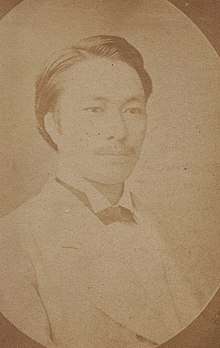Yoshida Kiyonari
Yoshida Kiyonari (Japanese: 吉田 清成; died 3 August 1891) was a Japanese samurai and diplomatic envoy to the United States.

Early life and education
In 1865, Yoshida was sent with Sameshima Naonobu and seventeen other samurai from Satsuma Domain to England to study Western science and technology.[1]:79 During 1867, Yoshida and Sameshima travelled with two others to the United States and joined the Brotherhood of the New Life, Thomas Lake Harris's Christian spiritual group.[1]:80 When they returned to England later that year, they claimed to have felt the presence of God through Harris' preaching in New York.[1]:79
Yoshida studied at University College London.[1]:60 He enrolled at New Jersey's Rutgers College in September 1868, but left after a few months.[2]:142 The following July, he registered at Wilbraham Academy (now Monson Academy) in Massachusetts and studied political economy.[2]:142
After graduating, he spent time in New York and Hartford, where he gained experience in banking.[2]:142
Career
He returned to Japan in 1870,[2]:142 and joined the Finance Ministry.[1]:60 He quickly became deputy junior minister, then head of the Tax Bureau, and finally deputy Vice Minister by November 1971.[2]:142 While working there, he secured a loan for Japan from the United States and Europe in 1971.[1]:60
He transferred to the Foreign Ministry,[1]:60 and in January 1874 he was appointed "extraordinary envoy and plenipotentiary minister" to the United States.[2]:142 In 1879, he arranged the visit of Ulysses S. Grant and his wife Julia Grant to Japan, and secured the return of funds from the United States Congress.[1]:60 He stayed in the position of envoy until 1882.
In July 1884, he became Vice Minister of Foreign Affairs, but fell out with Minister Inoue Kaoru.[2]:142–3 He was made Vice Minister of Agriculture and Commerce in September 1885.[2]:143
He was made an honorary member of the Genrōin in 1887, and awarded the title of viscount.[2]:143
Personal life
He became friends with the historian Henry Adams, with whom he shared an interest in archaic law.[3]
He died after a period of illness of 3 August 1891.[2]:143
References
- Sant, John E. Van (2000). Pacific Pioneers: Japanese Journeys to America and Hawaii, 1850-80. University of Illinois Press. ISBN 978-0-252-02560-0. Retrieved 4 December 2019.
- Cobbing, Andrew (2013). The Satsuma Students in Britain: Japan's Early Search for the essence of the West'. Routledge. ISBN 978-1-134-25202-2. Retrieved 4 December 2019.
- Samuels, Ernest (1989). Henry Adams. Harvard University Press. p. 131. ISBN 978-0-674-38735-5. Retrieved 4 December 2019.
| Diplomatic posts | ||
|---|---|---|
| Preceded by Jirō Yano |
Japanese Ambassador to the United States January 1874 – 1882 |
Succeeded by Munenori Terashima |